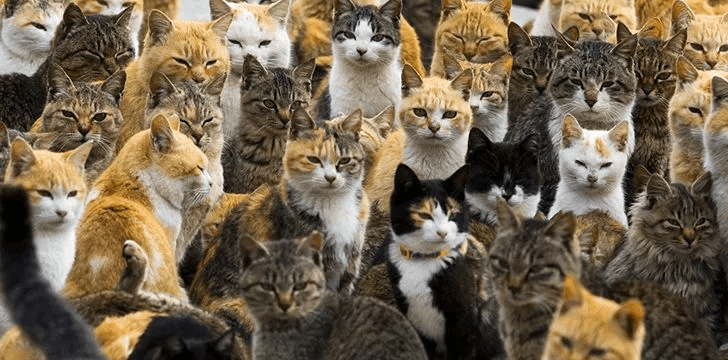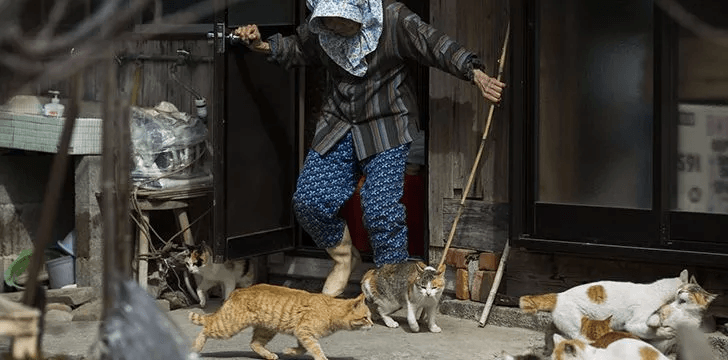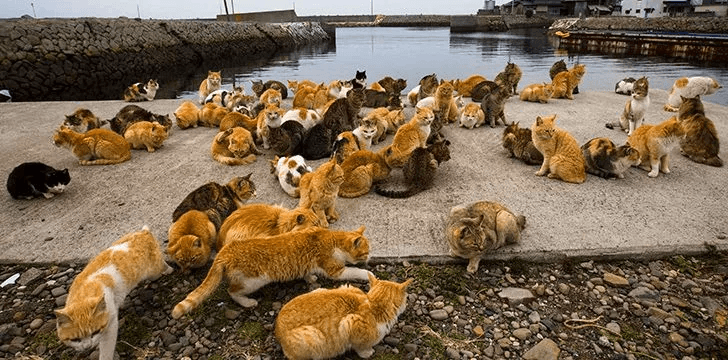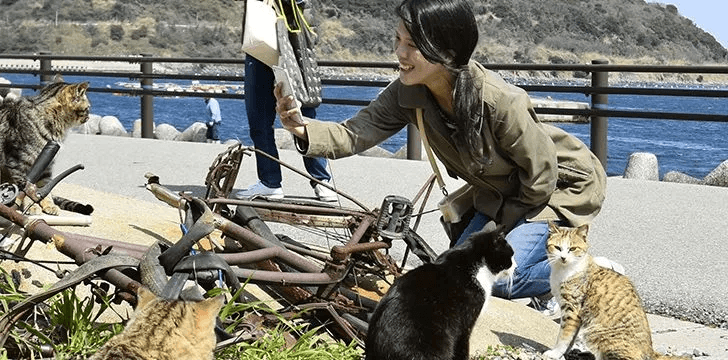
Japan is known for its love of animal themed attractions, from rabbit cafes in Tokyo, to the tame deer that wander around Nara and the snow monkeys of Jigokudani, that bathe in hot springs.
It has also become popular to give cats job roles, such as appointing cats as Lords of castles and managers of train stations to attract tourism.
But there is one furry attraction in particular that tops them all. That is the “Cat Islands” or “Neko-Shima” in Japanese.
That is correct, whole islands that are inhabited by the furry felines.
The Island of Aoshima, which is located in the Ehime prefecture, is the most well-known cat island, although there are multiple “Cat Islands” off Japan’s coastline and even on inland salt water lakes.
Tashiro-jima is the second best known island for cats, but now the concept is becoming a popular tourist attraction, more islands are becoming cat havens.
The 11 Islands are also known as “Cat Island” or “Neko-Shima”.

The names for the 11 cat islands are listed below, with the prefecture each island is located in.
- Okishima (Shiga prefecture)
- Sanagishima (Kagawa prefecture)
- Aoshima (Ehime prefecture)
- Muzukijima (Ehime prefecture)
- Manabeshima (Okayama prefecture)
- Iwaishima (Yamaguchi prefecture)
- Aijima (Fukuoka prefecture)
- Aishima (Fukuoka prefecture)
- Genkaishima (Fukuoka prefecture)
- Kadarashima (Saga prefecture)
- Tashiro-jima (Miyagi prefecture)
What is the Ratio of cats to humans on Cat Island?

The ratio of cats to humans varies from island to island, and as it develops to be a popular tourist attraction, islands are competing to have the most cats.
The island of Aoshima has an approximate ratio of 10 cats to every 1 human, with the island having only 13 human residents, it has over 150 felines.
Whilst the island of Tashiro-jima has a human population of 100 and over 100 cats, so their ratio is more like 1:1.
Manabeshima Island has the largest population of both humans and cats, with just under 300 humans and is said to have around the same number of cats to humans.
How did all the cats get there?

The stories of how all the cats got to these islands are unique depending on its location.
Most have a story revolving around rodent problems, but some have developed from myths and legends.
Aoshima, has so many cats because it was a fishing hot-spot back in the 1900’s and fishermen repeatedly had problems with mice on their boats, so would often adopt cats as a solution.
Over time the cats would venture onto the islands and this has led to their mass population now.
The island of Tashiro-jima however has a different story behind their cats.
The island was used to raise silkworms and which naturally attracted mice, therefore cats were introduction to help keep the mice population down.
Although there is no specific reason for the excessive amount of cats on Genakaishima Island, it was once the largest cat island, but it was hit hard by an earthquake in 2005.
This destroyed most of the island, but positively the number of felines has been rising since.
On the island of Kadarashima, legends tells that a dog had disobeyed it’s master and so the Yasakajinja Shrine (located on the island) put its wrath on all dogs, resulting in the species being driven from the island.
To this day no canines live on the island; therefore it is a cat’s paradise.
How the Cat Islands help with tourism in Japan.

The Cat Islands attract tourists all year round, and some of the islanders and tourism boards have been working to develop these as attractions.
The island of Tashiro-jima has even built a cat shrine, honoring the cats of the island for their service and work.
This has now become a popular shrine to visit by tourists.
Japan has always been affected by bad weather and earthquakes, so cat tourism is becoming a method of bringing tourists into areas that have been devastated.
By bringing in tourism, the islands are now receiving funds to restore some of the affected areas.
So if you are a cat lover, then Japan is the place to visit.
Although the majority of the cat islands were not purpose built tourist attractions, they are becoming increasingly popular to visit.
By visiting one of the cat islands you could be helping out a community by supporting its tourism and you get to hang out with cats all day.





